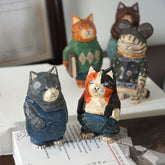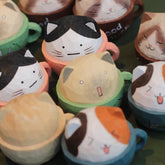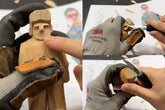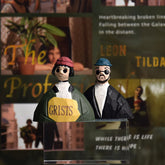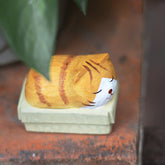How to Place Joints Correctly When Carving Wooden Gifts
In the last post, we talked about how keeping a balanced proportion between the upper and lower body is important when making human-shaped wooden gifts. But there’s another key element that adds beauty to your carved figures: making sure the joints are positioned in a way that fits human anatomy. In this blog, we’re going to help you understand the proportion and placement of joints in a human figure.
You only really need to remember a few important joint positions:
- The shoulders on a wood figurine are usually sloped downward, and the top point of the shoulder sits around the collarbone area.
- The elbow joint is just slightly above the belly button.
- The wrist is a little above the pubic bone.
These three spots basically determine how the arms move on your figure.

Let’s go through an example to show how important joint placement is on human-shaped wooden gifts.

Take this little wood figurine—the arm is posed like it’s in a pocket, maybe in a jacket or pants. Where should the elbow be bent or placed to make that look natural? What’s the right length? You can use some reference points, like the belly button, collarbone, chest, or pubic bone. Just remember the three main points of the arm: the shoulder joint, elbow joint, and wrist joint. As long as those three are placed somewhere near the correct areas, the pose won’t look weird.

Next up is the knee joint. The knee sits right around the middle point between the ankle and the pubic bone.
Once you’ve nailed down the knee position, you can add folds in the clothing at that spot. Once you carve the knee and butt area, the figure will start to look more three-dimensional from the side.

The proportions and structure we just talked about don’t need to be as detailed as a realistic drawing. When it comes to proportion, the head is the key. You can use it as a measuring tool to figure out the length of other body parts.
When it comes to structure, it’s all about the joints. Pay attention to where the joints are and how much they can move. For example, if you want to make a figure with one arm raised, the position of the joints doesn’t actually change that much. Like in this diagram, if you shift the joint positions slightly, the arm is lifted.

But in practice, it’s a lot more complicated than drawing. That’s because the wooden gifts we make include clothing, hair, and sometimes accessories like hats or backpacks. The clothes might be long or short, the pants could be loose or tight.
For all these different situations, you just need to identify the key proportion spots—like the ratio between the upper and lower body, the length of each limb segment, and the location of the joints. As long as you place those key joints correctly and logically, the figure you create won’t end up looking off.



